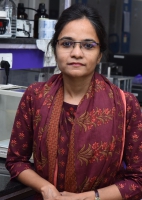The primary focus of my lab is to understand how the intrauterine environment regulates the development of lean muscle and fat and thereby determines infant body composition. To recapitulate intrauterine influences on fetal lean muscle development, we have developed a robust protocol to obtain cells of the myogenic lineage from umbilical cord-derived mesenchymal stem cells (uMSCs). This provides us with a platform to address how maternal micronutrients affect lean muscle development.
Another objective of the lab is to determine inter-generational effects of maternal lean muscle on offspring lean muscle function and metabolism. Lean muscle plays a significant role in systemic metabolism by regulating glucose homeostasis and secreting signalling peptides called Myokines. These myokines are secreted in response to muscular contractions that influence that affect growth and signalling in a autocrine and paracrine manner. Reduced lean muscle proportions that have been documented within the Indian ethnicity as compared to other Asian or European ethnicities are responsible for early predisposition of Indian infants to multiple non communicable diseases. Using mouse models, we aim to determine molecular signalling pathways in the maternal-infant crosstalk that determine lean muscle proportions and metabolic trajectories in the offspring.
Anamica D, Neha Jawla, Vaidehee Meena, Suchitra D.Gopinath, G.Aneeshkumar Arimbasseri (2023) Lack of vitamin D signaling shifts skeletal muscles towards oxidative metabolism Journal of Cachexia, Sarcopenia and Muscle DOI: 10.1002/jcsm.13378
Sevak JK & Gopinath S.D*. Generation of mesenchymal stem cells from human umbilical cord tissue and their differentiation into the skeletal muscle lineage. J.Vis. Exp. (JoVE), e63725, doi; 10.3791/63725 (2022)
Das A, Gopinath S.D* & G Aneeshkumar Arimbasseri* (2021). Systemic ablation of vitamin D receptor leads to skeletal muscle glycogen storage deficit disorder in mice. Journal of Cachexia, Sarcopenia and Muscle. DOI: 10.1002/jcsm.12841.
Mishra S, Sevak JK, Das Anamica, Arimbasseri G Aneeshkumar, Bhatnagar Shinjini and Gopinath S.D*. (2020). Umbilical cord tissue is a robust source for mesenchymal stem cells with enhanced myogenic differentiation potential compared to cord blood. Scientific Reports. 10 (18978). doi.org/10.1038/s41598-020-75102-9
Kumar A, Kumar Y, Kumar J, Kumar S, Kumar N, and Gopinath S.D* (2020). Metabolomic analysis of primary human skeletal muscle cellsduring myogenic progression. Scientific Reports. 10(1184). doi .10.1038/s41598-020-68796-4
Gopinath S.D (2017) Inhibition of Stat3 signaling ameliorates atrophy of the soleus muscles in mice lacking the vitamin D receptor. Skeletal Muscle . 7:2. doi. 10.1186/s13395-017-0121-2
Biressi S* and Gopinath S.D* (2015) The quasi-parallel lives of satellite cells and atrophying muscle. Front.Aging Neurosci. doi: 10.3389/fnagi.2015.00140 (*co- corresponding author).
Biressi S., Miyabara E., Gopinath S.D., Carlig P., Rando T.A (2014) Wnt-TGFb2 axis regulates the fate of muscle stem cells in dystrophic muscles. Sci Transl Med. Dec 17;6(267):267ra176. doi:10.1126/scitranslmed.3008411.
Gopinath S.D., Webb E.A., Brunet A., Rando T.A. (2014) FOXO3 promotes quiescence in adult muscle stem cells during the process of self-renewal. Stem Cell Reports, April 8 (2): 414-426.
Gopinath S.D., Rando T.A. (2008). Stem Cell review Series: Aging of the skeletal muscle stem cell niche. Aging Cell Aug;7(4):590-8.
Gopinath S.D., Narumiya S, Dhawan J (2007). The RhoA effector mDiaphanous regulates MyoD expression via SRF- dependent and SRF-independent pathways. J. Cell Sci. Sep 1;120(Pt 17):3086-98.
1. Effect of maternal micronutrients on offspring lean muscle proportions
2. Generation of in vitro models mimicking intra uterine muscle development and physiology
3. Developing models to address ntergenerational body compostion phenotypes to address how maternal body composition might influence offspring metabolic profiles and lean muscle proportions
1) Junior Research Fellowship awarded by the Counsil of Scientific and Industrial Research (CSIR), India
2) Senior Research Fellowship awarded by the Council of Scientific and Industrial Research (CSIR), India
3) American Society for Cell Biology (ASCB) Predoctoral Travel Award, 2004
4) Innovative Young Biotechnologist (IYBA) Award-2015
5) CSIR Travel grant Award for attending Gordon Research Conference on Myogenesis in Tuscany, Il Ciocco, June 2017
Scientific communication:
Science2October2015:30-31.“Fundingdreams”. http://www.sciencemag.org/content/350/6256/30.full
Science 3 July 2015: 24-27. “Postdocs reimagined”.http://www.sciencemag.org/content/349/6243/24/ suppl/DC1
Science 01 April 2016: 28-30. “Measures of Success”.http://science.sciencemag.org/content/352/6281/28/suppl/DC
Science 01 January 2021: 22-24. “Defining events: 2020 in hindsight”.https://science.sciencemag.org/content/371/6524
Committee membership:
Stem Cell Ethics Committee of Regional Centre of Biotechnology (RCB), 2019-2020
Reviewer role
Scientific Reports, Gut Microbiome, Journal of Cellular Physiology, Journal of Steroid Biochemistry and Molecular Biology, Frontiers in Physiology, Journal of Stem Cell research and Therapy, Biological Procedures Online, Journal of Biosciences
Poster presentation and talks (International)
- InvitedspeakerattheEuropeanMolecularBiologyOrganization(EMBO)workshop,on“Cellinteractionsin development and Disease” on Dec 16th-18th 2004, at Centre for Cellular and Molecular Biology, Hyderabad,India, “Regulation of MyoD inmyoblasts”.
- Poster Presentation at the FASEB Conference: Skeletal Muscle Satellite and Stem Cells, Carefree, USA, Jul2010.“Regulation of satellite cell function by the FoxO family of transcriptionfactors”.
- InvitedspeakerattheGordonResearchConference:Notchsignalingindevelopment,regenerationanddisease, Maine,USA,August 12-18th2012.“RegulationofNotchsignalingbyFoxO3inmusclestemcellsduringmuscle regeneration”.
- Poster presentation at the Gordon Research Conference: Myogenesis, Renaissance, Il Ciocco, Lucca, Barga, Tuscany, Italy. June 11th -16th, 2017. “Role of vitamin D signaling in the regulation of skeletal muscle mass”.

MS. PRIYANKA
PH.D STUDENT


